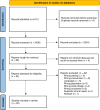Internal evaluation of medical programs is more than housework: A scoping review
- PMID: 39453962
- PMCID: PMC11508059
- DOI: 10.1371/journal.pone.0305996
Internal evaluation of medical programs is more than housework: A scoping review
Abstract
Purpose: The aim of this scoping review was to explore current program evaluation practices across various medical schools.
Methods: We conducted searches in MEDLINE (Ovid), Embase (Elsevier) and ERIC (ed.gov) for original research and review articles related to medical education evaluation with key words evaluation, program, medical education, pre-registration, framework, curriculum, outcomes, evaluation, quality. We followed Arksey and O'Malley's (2005) process for scoping reviews.
Results: Thirty-two articles were included. Studies were primarily concerned with either proving (n = 21) or improving efficacy of their programs (n = 11). No studies aimed at comparing programs. Nine were literature reviews. Others aimed to develop a new evaluation model (n = 7) or apply (n = 12) or validate (n = 4) an existing model (or part thereof). Twenty-two studies explicitly identified an evaluation model they had used or would recommend. Most frequently used models for evaluation were: Context-Input-Process-Product, Kirkpatrick, World Federation Medical Education, and the Standards by Joint Committee on Standards for Educational Evaluation. Overall, evaluations were learner-focused and accreditation driven with a minority considering the broader influences of program success.
Conclusion: Program evaluation is fundamental to driving the quality of education delivered to produce workforce-ready healthcare professionals. The focus of current evaluations is on student experience and content delivery with a significant gap in the existing literature on evaluation related to staff, learner/staff well-being, equity, diversity, and meta evaluation.
Copyright: © 2024 Kodagoda Gamage et al. This is an open access article distributed under the terms of the Creative Commons Attribution License, which permits unrestricted use, distribution, and reproduction in any medium, provided the original author and source are credited.
Conflict of interest statement
The authors have declared that no competing interests exist.
Figures
References
-
- ACGME. Glossary of Terms 2023. [cited 2023 02.12.2023]. Available from: https://www.acgme-i.org/accreditation-process/glossary/.
-
- Stufflebeam DL SA. Systematic evaluation: A self-instructional guide to theory and practice.: Springer Science & Business Media; 2012. Dec 6.
Publication types
MeSH terms
LinkOut - more resources
Full Text Sources
Miscellaneous


